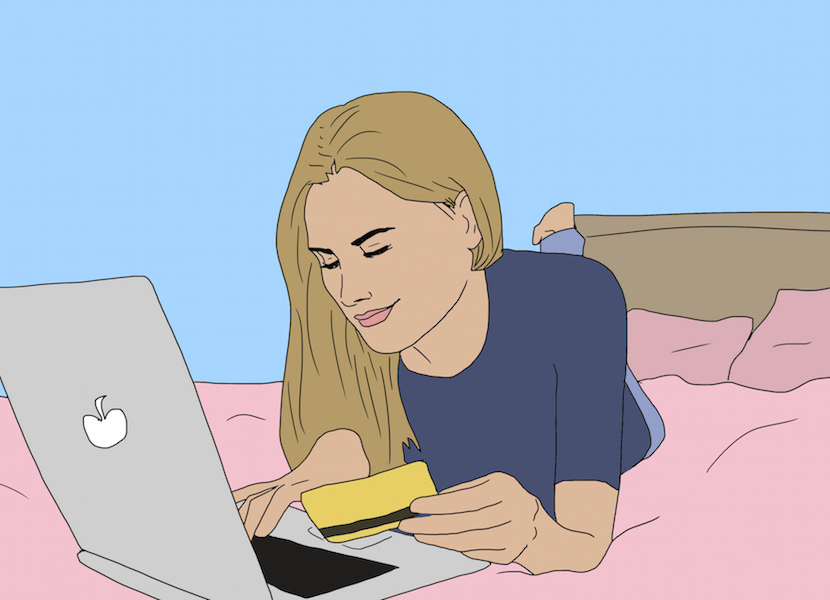Why Afterpay is actually fuelling your shopping addiction
Illustration by Twylamae
Words by Jonti Ridley
Purchase-induced dopamine highs can be a very slippery slope.
For many of us on fixed incomes, or small amounts of disposable income, ‘buy-now, pay-later’ options make it easier than ever to make purchases we otherwise may not be able to afford. It’s no doubt easier to make four payments of $100 rather than $400 in one go, but this means many people are unknowingly sliding into a toxic relationship with the payment platform.
You’ve probably seen it before, self-confessed ‘Afterpay Addicts’ posting memes or discussing purchases hidden from their partners. It’s a quirky alliteration often used as marketing on social media platforms which makes light of the very real addictive nature of online shopping. More and more brands have embraced the glamorising of addiction as a troubling trend in marketing campaigns — a trend Estèe Laundry has done a great job unpacking on its page.
The instant purchase model means you get both the dopamine release of making the purchase and the quick arrival of your new Thing. As with all good brain chemicals, it’s easy to become addicted. When you hit ‘add to cart’ or even see the word ‘sale’, a switch goes off to release those chemicals and make you happy. When the product arrives it happens again, offering positive reinforcement that the process was a good choice.
Layby isn’t a new concept, but that model requires you to wait until you’ve paid your total off before you receive a product. Additionally, layby is usually an in store only service, so you’re more aware of the money you’re regularly contributing. The digital landscape of platforms such as Afterpay means you never actually see cash exchanged, which makes it difficult for your brain to tie the numbers on the screen to your monetary assets.
We all know the rule, if you miss a payment you’ll be fined a ‘maximum’ late fee of $10. If you didn’t know, this is only if your order is below $40 in value. If it exceeds this amount, late fees will continue in $7 increments (weekly) until the total reaches ‘25% of the original order value’ or $68, whatever comes first.
For its part, Afterpay does an honest job of informing the customer of this before they use the service. It’s in the highlighted Terms, plain and simple. Reminders are sent to the consumer days prior, alerting them a repayment is coming up. Afterpay also allows you to contact the service if you’re facing hardship and unable to meet your payments. However, if you don’t have $50 to meet your payment, it’s unlikely you have a spare $68 for late fees. When you’re using the platform for multiple micro-transactions, stacks of $10 fees add up quicker than you think.
Also yes, your credit rating can be affected by Afterpay, but not in the way you think. Afterpay holds the right to complete a credit history check on you, to ensure you’re a good investment and you can repay what you owe, and ‘report negative activity on your account’. This means if you fail to meet your repayments, this may be passed onto a credit rating agency (the very one they used to do a checkup on you in the first place). This is also discussed in the platform’s terms (available online), but I know more than a few of you clicked the ‘agree’ button without actually reading it.
Again, entirely to its credit, Afterpay is aware of this slippery slope. It offers resources and support to customers who feel their spending is escalating. The ‘Responsible Spending’ page also links users to other support systems and budgeting software. ‘Buy now, pay later’ platforms aren’t inherently to blame, but they do normalise this kind of spending and make it accessible. A study released in 2019 in Comprehensive Psychiatry suggests ‘Buying-shopping disorder’ should be recognized as an official mental disorder, but no change has been made as of yet.
We can all see the value in some retail therapy every now and again, but as with any addiction, it’s easy to develop a high tolerance with enough experience. This is where Afterpay can get tricky. Having your purchases financed means you don’t need to wait to make a purchase, which in turn means you can buy more and shop more often. Repeat this over and over, and the small purchases aren’t enough or the rate at which you’re buying isn’t quick enough. It’s also possible to go through withdrawals, experiencing feelings of depression when you don’t have an order on the way. Things escalate and you find yourself spending money you don’t have, swamped with late fees, your credit score on the decline and without the dopamine you were initially chasing.
I’m not suggesting the platform is the evil root of capitalistic spending. I use it frequently myself, and I’ve had more than one late fee to my name. But consumers should be aware of all the risks when they engage in dopamine seeking behaviour, not just the financial ones. Debt, depression and anxiety don’t seem worth it for a pair of shoes you could’ve waited two weeks for.













